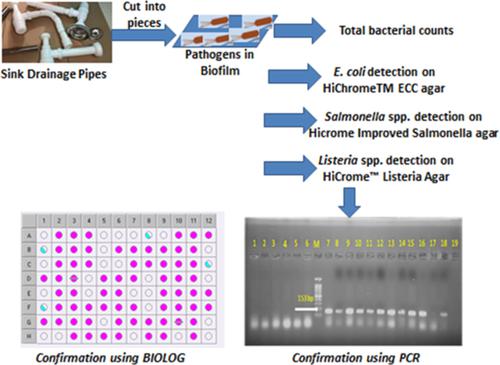当前位置:
X-MOL 学术
›
J. Food Saf.
›
论文详情
Our official English website, www.x-mol.net, welcomes your feedback! (Note: you will need to create a separate account there.)
Prevalence of E. coli, Salmonella, and Listeria spp. as potential pathogens: A comparative study for biofilm of sink drain environment
Journal of Food Safety ( IF 2.4 ) Pub Date : 2020-05-22 , DOI: 10.1111/jfs.12816 Mohamed Azab El‐Liethy 1 , Bahaa A. Hemdan 1 , Gamila E. El‐Taweel 1
Journal of Food Safety ( IF 2.4 ) Pub Date : 2020-05-22 , DOI: 10.1111/jfs.12816 Mohamed Azab El‐Liethy 1 , Bahaa A. Hemdan 1 , Gamila E. El‐Taweel 1
Affiliation

|
Since knowledge and understanding of waterborne pathogens and their diseases are well illuminated, a few research publications on the prevalence of pathogenic microorganisms in various household sink drain pipes are often not extensively examined. Therefore, this study aims to (a) assess and monitor the densities of the bacterial community in the different natural biofilm that grow on plastic pipelines, (b) to detect Escherichia coli, Salmonella, and Listeria spp. from natural biofilm samples that are collected from the kitchen (n = 30), bathroom (n = 10), laboratories (n = 13), and hospital (n = 8) sink drainage pipes. Three bacterial species selected were assessed using a culture‐dependent approach followed by verification of isolates using both BIOLOG GEN III and polymerase chain reaction. The estimated number of each bacterium was 122 isolates, while 60, 20, 26, and 16 isolates were obtained from the natural biofilm samples, kitchen, bathroom, laboratories, and hospital, respectively. As for the tests, in all types of biofilm samples, the overall bacterial counts at low temperature (22°C) were higher than those at high temperature (37°C). Meanwhile, E. coli had the most significant number of bacterial microorganisms compared to the other two pathogens. Additionally, the most massive cell densities of E. coli, Salmonella, and Listeria species were discovered in the biofilm collected from the kitchen, then the hospital. Statistically, the results reveal that there is a positive correlation (p ≥ .0001) with significance between the sources of biofilm. This work certainly makes the potential of household sink drain pipes for reservoir contagious pathogens more explicitly noticeable. Such knowledge would also be beneficial for prospective consideration of the threat to human public health and the environment.
中文翻译:

大肠杆菌,沙门氏菌和李斯特菌属的流行。作为潜在病原体:水槽排水环境生物膜的比较研究
由于对水传播病原体及其病害的知识和理解得到了很好的阐明,因此很少对有关各种家庭水槽排水管中病原微生物的普遍性的研究出版物进行广泛的研究。因此,本研究旨在(a)评估和监测在塑料管道上生长的不同天然生物膜中细菌群落的密度,(b)检测大肠杆菌,沙门氏菌和李斯特菌。从厨房(n = 30),洗手间(n = 10),实验室(n = 13)和医院(n= 8)水槽排水管。使用依赖于培养物的方法对选择的三种细菌进行评估,然后使用BIOLOG GEN III和聚合酶链反应对分离株进行验证。每种细菌的估计数量为122个菌株,而天然生物膜样品,厨房,浴室,实验室和医院分别获得60、20、26和16个菌株。至于测试,在所有类型的生物膜样品中,低温(22°C)时的总体细菌计数高于高温(37°C)时的细菌总数。同时,E。与其他两种病原体相比,大肠杆菌的细菌微生物数量最多。此外,E的最大细胞密度。大肠杆菌,在从厨房到医院的生物膜中发现了沙门氏菌和李斯特菌。经统计学处理,结果表明,有一个正相关(p ≥0.0001)与生物膜的源极之间的意义。这项工作无疑使家用水槽排水管对水库传染性病原体的潜力更加明显。这些知识也有助于对人类公共健康和环境的威胁进行前瞻性的考虑。
更新日期:2020-05-22
中文翻译:

大肠杆菌,沙门氏菌和李斯特菌属的流行。作为潜在病原体:水槽排水环境生物膜的比较研究
由于对水传播病原体及其病害的知识和理解得到了很好的阐明,因此很少对有关各种家庭水槽排水管中病原微生物的普遍性的研究出版物进行广泛的研究。因此,本研究旨在(a)评估和监测在塑料管道上生长的不同天然生物膜中细菌群落的密度,(b)检测大肠杆菌,沙门氏菌和李斯特菌。从厨房(n = 30),洗手间(n = 10),实验室(n = 13)和医院(n= 8)水槽排水管。使用依赖于培养物的方法对选择的三种细菌进行评估,然后使用BIOLOG GEN III和聚合酶链反应对分离株进行验证。每种细菌的估计数量为122个菌株,而天然生物膜样品,厨房,浴室,实验室和医院分别获得60、20、26和16个菌株。至于测试,在所有类型的生物膜样品中,低温(22°C)时的总体细菌计数高于高温(37°C)时的细菌总数。同时,E。与其他两种病原体相比,大肠杆菌的细菌微生物数量最多。此外,E的最大细胞密度。大肠杆菌,在从厨房到医院的生物膜中发现了沙门氏菌和李斯特菌。经统计学处理,结果表明,有一个正相关(p ≥0.0001)与生物膜的源极之间的意义。这项工作无疑使家用水槽排水管对水库传染性病原体的潜力更加明显。这些知识也有助于对人类公共健康和环境的威胁进行前瞻性的考虑。



























 京公网安备 11010802027423号
京公网安备 11010802027423号